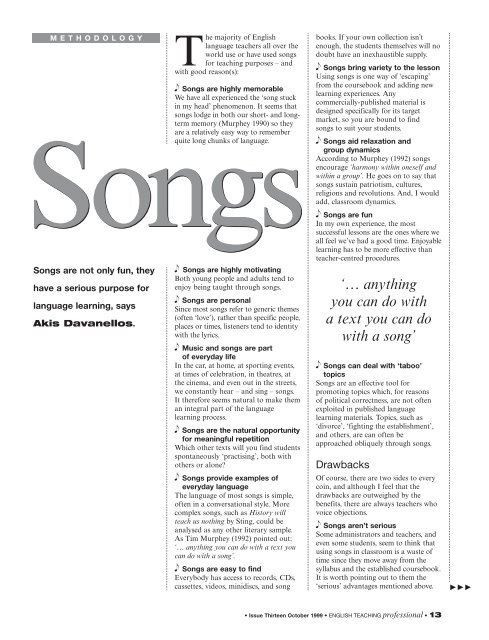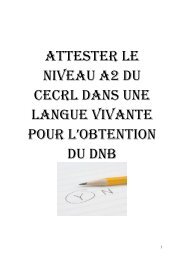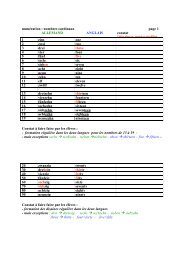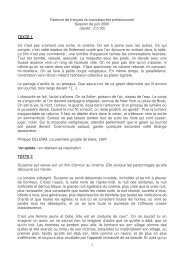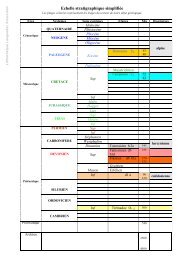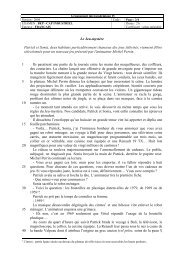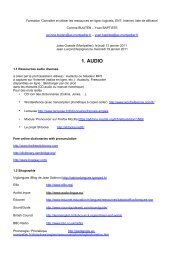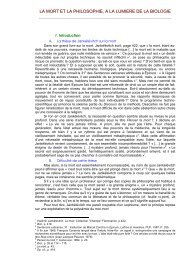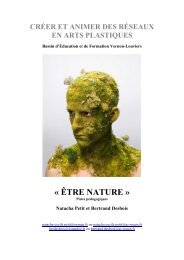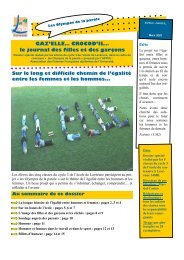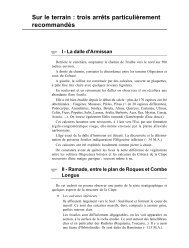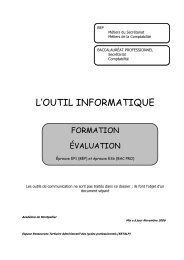ETp Issue 13 Imposed
ETp Issue 13 Imposed
ETp Issue 13 Imposed
Create successful ePaper yourself
Turn your PDF publications into a flip-book with our unique Google optimized e-Paper software.
METHODOLOGY<br />
The majority of English<br />
language teachers all over the<br />
world use or have used songs<br />
for teaching purposes – and<br />
with good reason(s):<br />
Songs are highly memorable<br />
We have all experienced the ‘song stuck<br />
in my head’ phenomenon. It seems that<br />
songs lodge in both our short- and longterm<br />
memory (Murphey 1990) so they<br />
Songs<br />
are a relatively easy way to remember<br />
quite long chunks of language.<br />
Songs are not only fun, they<br />
have a serious purpose for<br />
language learning, says<br />
Akis Davanellos.<br />
Songs are highly motivating<br />
Both young people and adults tend to<br />
enjoy being taught through songs.<br />
Songs are personal<br />
Since most songs refer to generic themes<br />
(often ‘love’), rather than specific people,<br />
places or times, listeners tend to identity<br />
with the lyrics.<br />
Music and songs are part<br />
of everyday life<br />
In the car, at home, at sporting events,<br />
at times of celebration, in theatres, at<br />
the cinema, and even out in the streets,<br />
we constantly hear – and sing – songs.<br />
It therefore seems natural to make them<br />
an integral part of the language<br />
learning process.<br />
Songs are the natural opportunity<br />
for meaningful repetition<br />
Which other texts will you find students<br />
spontaneously ‘practising’, both with<br />
others or alone?<br />
Songs provide examples of<br />
everyday language<br />
The language of most songs is simple,<br />
often in a conversational style. More<br />
complex songs, such as History will<br />
teach us nothing by Sting, could be<br />
analysed as any other literary sample.<br />
As Tim Murphey (1992) pointed out:<br />
‘… anything you can do with a text you<br />
can do with a song’.<br />
Songs are easy to find<br />
Everybody has access to records, CDs,<br />
cassettes, videos, minidiscs, and song<br />
books. If your own collection isn’t<br />
enough, the students themselves will no<br />
doubt have an inexhaustible supply.<br />
Songs bring variety to the lesson<br />
Using songs is one way of ‘escaping’<br />
from the coursebook and adding new<br />
learning experiences. Any<br />
commercially-published material is<br />
designed specifically for its target<br />
market, so you are bound to find<br />
songs to suit your students.<br />
Songs aid relaxation and<br />
group dynamics<br />
According to Murphey (1992) songs<br />
encourage ‘harmony within oneself and<br />
within a group’. He goes on to say that<br />
songs sustain patriotism, cultures,<br />
religions and revolutions. And, I would<br />
add, classroom dynamics.<br />
Songs are fun<br />
In my own experience, the most<br />
successful lessons are the ones where we<br />
all feel we’ve had a good time. Enjoyable<br />
learning has to be more effective than<br />
teacher-centred procedures.<br />
‘… anything<br />
you can do with<br />
a text you can do<br />
with a song’<br />
Songs can deal with ‘taboo’<br />
topics<br />
Songs are an effective tool for<br />
promoting topics which, for reasons<br />
of political correctness, are not often<br />
exploited in published language<br />
learning materials. Topics, such as<br />
‘divorce’, ‘fighting the establishment’,<br />
and others, are can often be<br />
approached obliquely through songs.<br />
Drawbacks<br />
Of course, there are two sides to every<br />
coin, and although I feel that the<br />
drawbacks are outweighed by the<br />
benefits, there are always teachers who<br />
voice objections.<br />
Songs aren’t serious<br />
Some administrators and teachers, and<br />
even some students, seem to think that<br />
using songs in classroom is a waste of<br />
time since they move away from the<br />
syllabus and the established coursebook.<br />
It is worth pointing out to them the<br />
‘serious’ advantages mentioned above.<br />
• <strong>Issue</strong> Thirteen October 1999 • ENGLISH TEACHING professional • <strong>13</strong>
Songs<br />
Songs contain poor quality<br />
language<br />
It is true that many songs include slang,<br />
bad grammar, and unnatural word<br />
stress. As with any other materials, it is<br />
important to select carefully.<br />
I can’t sing<br />
Using songs in the classroom does not<br />
require a teacher to be a music specialist<br />
or pop singer. While an interest in songs<br />
and music and a willingness to sing along<br />
with the cassette is desirable, the students<br />
are often happy to do the singing (and<br />
to realise that they too do not have to be<br />
perfect singers). There are many ways of<br />
presenting songs which do not require<br />
the teacher to sing and which leave the<br />
teacher ‘free’ to focus on the students.<br />
It’s too noisy<br />
Singing shouldn’t be any more noisy<br />
than a normal level of talk – and a<br />
certain level of noise has to be<br />
acceptable in a language class.<br />
I haven’t got the right equipment<br />
and it’s all too much hassle<br />
You do need equipment, but you may<br />
well find that students are only too<br />
happy to bring in their own portable<br />
machines, if the school cannot provide<br />
anything suitable.<br />
I can’t write my own materials<br />
Many teachers do not feel confident<br />
enough to exploit songs in a way which<br />
integrates them into the syllabus. I hope<br />
the rest of this article gives them some<br />
ideas – and confidence.<br />
Just one word of warning.<br />
Don’t overdo it! Once you’ve experienced<br />
all the benefits and joys of using songs<br />
in class, it’s too easy to use them again<br />
– and again. Remember to vary your<br />
language-learning activities so that<br />
students retain their enthusiasm.<br />
Songs as texts<br />
Earlier, I referred to Tim Murphey’s<br />
contention that songs may be exploited<br />
as effectively as any other text. They can<br />
14 • ENGLISH TEACHING professional • <strong>Issue</strong> Thirteen October 1999 •<br />
be a source of language for presenting<br />
and practising grammar and syntax,<br />
vocabulary, pronunciation, and the<br />
skills of listening, reading, speaking,<br />
writing and translation. Most of the<br />
ideas presented about songs in the rest<br />
of this article can therefore refer equally<br />
well to any reading and listening text.<br />
Songs (and texts) are traditionally<br />
exploited in three stages, with pre-study<br />
activities, while-studying activities, and<br />
post-study activities. Although real life<br />
is not quite so clearly delineated, the<br />
classification is a useful one.<br />
Pre-stage activities<br />
The purpose of this stage is to prepare<br />
the students linguistically, educationally,<br />
thematically and psychologically for the<br />
text. Students might be introduced to<br />
the topic and key vocabulary, or any<br />
linguistic feature(s) which might help<br />
them exploit the text effectively at a<br />
later stage.<br />
There are many ways of presenting songs<br />
which do not require the teacher to sing<br />
A vital element of the ‘pre-stage’ is<br />
establishing a reason for students to<br />
want to read or listen to the song/text.<br />
Typically, this might involve setting prequestions<br />
which students answer while<br />
encountering the text for the first time.<br />
While-stage activities<br />
During this stage, which might be<br />
seen as the main focus of the lesson,<br />
students perform tasks and activities<br />
which directly exploit the song. The<br />
tasks might be graded to get more<br />
difficult as they get into the song.<br />
For example, while listening to a song,<br />
such as An Englishman in New York<br />
by Sting, a gist-listening task might<br />
be to ask the students to identify the<br />
topic of the song. Still in the same<br />
stage, a later task might deal with<br />
specific information and require<br />
intensive listening or reading by asking<br />
students to mark statements ‘true’<br />
or ‘false’.<br />
During this stage, students are<br />
frequently required to perform parallel<br />
tasks, ie read the text while making<br />
notes about X, or listen to the song and<br />
underline X in the text.<br />
After the detailed exploitation of<br />
the song, students might then be asked<br />
to reflect on its language and content.<br />
Post-stage activities<br />
This third stage typically involves<br />
follow-up activities which practise the<br />
productive skills of speaking and<br />
writing in various ways.<br />
In the previous stages, the students<br />
might have been speaking or writing in<br />
order to complete a task, eg in the prestage<br />
students might discuss their<br />
personal experience of the theme.<br />
However, the purpose and focus of the<br />
pre-stage is not the development of<br />
these skills, but the means for<br />
increasing motivation and introducing<br />
the topic.<br />
In the post stage, it is the song or<br />
text which provides the stimulus for<br />
further activities which enhance other<br />
language skills. A classic example is the<br />
follow-up work to She’s leaving home<br />
by the Beatles, where students either<br />
roleplay the dialogue between the girl<br />
and her parents, or write the letter the<br />
girl left for her parents.<br />
During this stage, the tasks and<br />
activities will almost certainly involve<br />
the integration of previously-taught<br />
language with new language and ideas<br />
recently introduced through the song.<br />
And, of course, once students have<br />
done all this work, their reward might<br />
be to sing the song together.<br />
!<br />
<br />
The quiz on the next page gives<br />
a list of 40 activities which<br />
might profitably be used to<br />
exploit songs (and other texts) in the<br />
language classroom at each of the three<br />
stages. I hope it will provide a useful<br />
springboard to some enjoyable song-<br />
filled lessons.<br />
Ep T<br />
<br />
Key to quiz These are only suggestions.<br />
The important thing is to build up a variety of<br />
interesting activities relevant to your students.<br />
Numbers in bold italics appear in more than one<br />
category.<br />
Before 1, 3, 9, 15, 16, 19, 23, 24, 25, 29,<br />
38, 39<br />
During 3, 4, 5, 6, 7, 8, 11, 12, 14, 17, 18, 20,<br />
27, 28, 31, 32, 35, 37, 39, 40<br />
After 2, 3, 6, 7, 9, 10, 11, <strong>13</strong>, 14, 15, 16, 18, 19,<br />
21, 22, 26, 29, 30, 33, 34, 35, 36, 38, 39, 40<br />
Akis Davanellos is<br />
Director of Studies in<br />
Lamia, Greece, and the<br />
initiator of the IGUANA<br />
project – a non-profitmaking,<br />
research-based<br />
project which aims to<br />
empower practising<br />
teachers. He is the<br />
designer of Film Time,<br />
an authentic video<br />
series, and the Rock ’n’<br />
EFL resource pack.
Activities for exploiting songs and texts <br />
Decide whether these activities are most appropriate as pre-listening activities (mark them B for ‘before’),<br />
activities while listening (D for ‘during’) or post-listening follow-up activities (A for ‘after’).<br />
Some may be suitable for more than one stage.<br />
1 Students predict the content of the text by<br />
reading its title.<br />
2 Students write a dialogue between the<br />
characters.<br />
3 Cut up and mix the lines (sentences) of the text.<br />
Students order the jumbled sentences.<br />
4 Students read or listen to the text to confirm what<br />
was predicted during the ‘pre’ stage.<br />
5 Students read a gapped text and fill in the blanks.<br />
6 Students read the text and delete words to create<br />
a gap-fill task for others.<br />
7 Students write a letter to or from one of the<br />
characters in the text.<br />
8 Students read or listen to the text to extract the<br />
information to write a summary.<br />
9 Jumble the words/letters of the title of the text<br />
for the students to reconstruct.<br />
10 Students write their own lyrics to the tune of<br />
the song.<br />
11 Students read or listen to the text and identify<br />
stress, rhythm and intonation patterns.<br />
12 Students read or listen to the text and put<br />
photographs/cartoon pictures in the correct order.<br />
<strong>13</strong> Students interview one of the characters.<br />
14 Students invent a title for each paragraph/verse<br />
and an overall title for the text/song.<br />
15 Students brainstorm ideas about the topic.<br />
16 Use the text as a springboard to initiate<br />
discussions to develop students’ ideas about<br />
the topic.<br />
17 Students answer multiple choice/comprehension<br />
questions, etc.<br />
18 Students create their own multiple<br />
choice/comprehension questions for others.<br />
19 Students describe/discuss photographs/pictures<br />
related to the topic.<br />
20 Students identify the meaning of<br />
words/expressions as used in the text.<br />
21 Students roleplay (parts of) the situation as<br />
described in the text.<br />
22 Students write a reply to the author/singer.<br />
23 Pre-teach the necessary vocabulary to help<br />
students understand the text.<br />
24 Students predict possible vocabulary items which<br />
may appear in the text.<br />
25 Students brainstorm the vocabulary which might<br />
be associated with the topic.<br />
26 Students re-write the text from another<br />
character’s point of view.<br />
27 Students listen to the song and take dictation.<br />
28 Students identify deliberate mistakes (of<br />
vocabulary, grammar, syntax, etc).<br />
29 Students design posters relating to the topic or<br />
promoting the song which are then displayed.<br />
30 Students perform the song.<br />
31 Omit words and replace them with a relevant<br />
drawing. Students identify the missing words<br />
before reading or listening to the text.<br />
32 Omit words to produce a gapped text. Students<br />
reconstruct the text by choosing the correct word<br />
from the list. (At higher levels, give more words<br />
than students need.)<br />
33 Students write a summary of the text.<br />
34 Students invent essay titles relating to the topic of<br />
the text (and write one of the essays).<br />
35 Students create or complete charts or diagrams<br />
about the text.<br />
36 Students select or write songs to produce a class<br />
song book.<br />
37 After the song/text is finished, students predict<br />
what happens next.<br />
38 Students write and give a speech on the topic.<br />
39 Design activities on the text which are similar to<br />
examination questions.<br />
40 Students sing the song and record it. Play it again<br />
and improve on pronunciation.<br />
• <strong>Issue</strong> Thirteen October 1999 • ENGLISH TEACHING professional • 15


